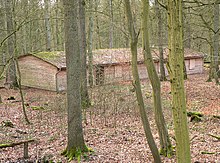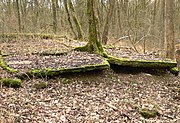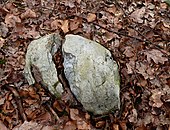Lenner camp

The Lenner camp was in the era of National Socialism a labor camp for forced laborers . It was at the foot of the Hils mountain range near the municipality of Lenne in the Holzminden district in southern Lower Saxony . The camp with around 40 to 60 barracks existed from September 1944 to April 1945 and was occupied by around 5,000 forced laborers.
prehistory
After the Allies had gained air superiority over Germany from 1943 onwards , in the summer of 1944 the plan arose to develop the Hils into an armaments focus in the German Reich. The widespread pit and tunnel system of Deutsche Asphalt AG offered ideal conditions for the underground relocation of the armaments industry . The densely wooded Hils also provided above-ground production facilities with protection from enemy air raids. Accordingly, production facilities for the manufacture of fighter planes and other armaments were created under the direction of the Todt Organization and according to the plans of the Jägerstab . More than 10,000 forced laborers were temporarily employed in over 30 camps at Hils.
description
The Lenner camp had the code name Hecht IV and was set up in a forest area for camouflage reasons. It was the main warehouse of the developing armaments complex in the Hils. Other camps nearby included the Holzen subcamp and the Holzen penitentiary camp . The warehouse was created for workers who were to produce the Focke-Wulf Ta 152 fighter aircraft in a forest factory in the Nonnensiek forest area . It was a project of the Air Force , with the Volkswagen was commissioned and the Ferdinand Porsche headed.
The construction of the camp began in September 1944 with the excavation of building foundations. It was not completed, as indicated by remaining cement sacks on the site to this day. Originally planned were 56 team barracks and 12 farm barracks. Allied aerial photographs taken after the end of the war show around 60 buildings in the forest. Today there are still around 40 barrack foundations.
Two types of barracks were built, made of precast concrete or wood. They were 10 × 25 meters in size and had four rooms of 5 × 12 meters. The entrances were partially relocated to the inside so that they offered a windbreak. Each room had three-story beds for 24 people, lockers, stools and a cannon stove . At times the occupancy was doubled. The average was 32 prisoners per room. The camp was only partially fenced. When setting up the camp, the daily workload of an inmate was digging out three m 3 of earth.
On December 30, 1944, around 500 people were recorded as camp inmates in the labor camp run by Organization Todt. The inmates belonged to a wide variety of groups. These included people from the Soviet Union, Italy and Poland. The German inmates who were citizens of the Reich were Jews , Jewish mongrels and so-called Jewish people with different kinds of people. Prisoners who became known later were Klaus-Peter Bruns , Klaus Traube , Wilhelm Nolting-Hauff and Lothar Urbanczyk .
Eviction of the camp
In April 1945 when Allied troops approached, many prisoners fled the camp, which was only partially fenced. Concentration camp prisoners who were on the run were locked in the empty barracks . The remaining prisoners were put on a march towards Harz , but were liberated by American troops on the way. The camp was liberated by US troops on April 7, 1945. The prisoners returned to their home countries. The camp served as accommodation for displaced persons for a while . The barracks were later sold or used as firewood.
today

In the 1980s, regional institutions dealt with the history of arms production and forced labor in the Holzminden district during the Nazi era. The results of their research were made available to the public through memorial sites, guided tours and book publications. Starting in 2006, the Holzminden District Adult Education Center transformed the former Lenne camp into a memorial site with the help of a youth project . This includes a nature trail that begins on the B 64 with an information pavilion and is called the “Path of Remembrance of Forced Labor” to the former camp site. A wooden barrack was rebuilt in its original size on the foundations of an earlier warehouse. The permanent exhibition “Forced Labor for Armaments under National Socialism”, which opened in 2009 and presents the history of armaments projects from 1943 to 1945 in the Eschershausen area , is located in the four rooms . Everyday utensils that were found during archaeological excavations are also on display . The exhibition was funded by the LEADER program. In 2009 the Lower Saxony Memorial Foundation added the Lenn camp to the list of official memorials in Lower Saxony.
literature
- Detlef Creydt (Ed.): Lenne camp in: Forced labor for industry and armaments in Hils 1943–1945. Verlag Jörg Mitzkat , Holzminden, 2001, ISBN 3-931656-37-3 Volume 4, pp. 233-238.
- Vanessa Giesin, Manfred Grieger : The new permanent exhibition in the “Memorial Site for Forced Laborers of National Socialism in the Holzminden District” in the former Nazi armaments center in Hils in: Intermediate spaces: Displaced persons, internees and refugees in former concentration camps , issue 12, Bremen, Edition Temmen , 2010 , Pp. 184-186
Web links
- Memorial for forced laborers during the Nazi era in the Lenn camp at the Federal Agency for Civic Education
- Kreisvolkshochschule Holzminden: Lenner Lager memorial site
- Exhibition "Black Land"
- Commemoration in the “Lenner Lager”. Don't forget the horrors of the past. “Never again right-wing extremism” in Dewezet on April 18, 2008
- Forgotten camp memorial given in Dewezet from September 15, 2009
- Lenne concentration camp near Eschershausen on June 8, 2013
Coordinates: 51 ° 54 ′ 17 " N , 9 ° 41 ′ 51" E




